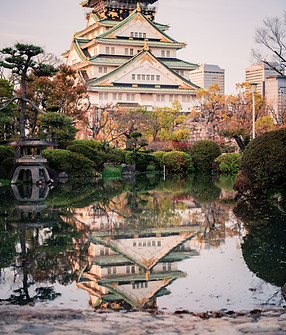


TOKYO
Tokyo, Japan’s busy capital, mixes the ultramodern and the traditional, from neon-lit skyscrapers to historic temples. The opulent Meiji Shinto Shrine is known for its towering gate and surrounding woods. The Imperial Palace sits amid large public gardens. The city's many museums offer exhibits ranging from classical art (in the Tokyo National Museum) to a reconstructed kabuki theater.

HAKONE
Hakone, in Japan's Fuji-Hakone-Izu National Park west of Tokyo, is a mountainous town known for its hot springs resorts (onsen) and views of the iconic volcano Mount Fuji. It also encompasses Hakone Shrine, a Shinto shrine with a red “torii” gate overlooking Lake Ashi, which can be toured by boat, as well as the boiling sulphur springs of the Owakudani Valley.

OSAKA
Osaka is known for its modern architecture, nightlife and hearty street food. The 16th-century shogunate Osaka Castle, which has undergone several restorations, is its main historical landmark. It's surrounded by a moat and park with plum, peach and cherry-blossom trees. Sumiyoshi-taisha is among Japan’s oldest Shinto shrines.

KAMAKURA
Kamakura is a seaside city just south of Tokyo. The political center of medieval Japan, modern-day Kamakura is a prominent resort town with dozens of Buddhist Zen temples and Shinto shrines. Its most recognizable landmark is the Kotoku-in Temple’s Great Buddha, a roughly 13m-high bronze statue still standing after a 15th-century tsunami.

MT. FUJI
Japan’s Mt. Fuji is an active volcano about 100 kilometers southwest of Tokyo. Commonly called “Fuji-san,” it’s the country’s tallest peak, at 3,776 meters. One of Japan’s 3 sacred mountains, and summit hikes remain a popular activity. Its iconic profile is the subject of numerous works of art, notably Edo Period prints by Hokusai and Hiroshige.

KYOTO
Kyoto is considered the cultural capital of Japan and is a major tourist destination. It is home to numerous Buddhist temples, Shinto shrines, palaces and gardens, some of which have been designated collectively as a World Heritage Site by UNESCO.

TOKYO NIGHT
Start your night off at a tachinomi standing bar before moving on to one of the many hole-in-the-wall izakayas for mouth watering local food and a vast selection of drinks. From there you can hop from one izakaya to the next to enjoy all the different foods that each shop has to offer. Tokyo is known for their delicious monjayaki, yakitori, ramen, sushi and fresh seafood.

OSAKA NIGHT
Osaka is a city with neon lights and known for their lively population and active night. There are numerous street foods along the main strip to fulfill your taste buds and quench your thirst. Some of the popular foods are okonomiyaki, kushi katsu, doteyaki and oshi- zushi.

EVENTS / ENTERTAIMENT
Want to watch a live sumo match or a professional baseball game? Japan has many events and attractions that you can enjoy. Japan offers many attractions such as Tokyo Disneyland, Disney Sea, Tokyo Sky Tree, Tokyo Tower as well as Universal Studios Japan in Osaka.

KARUIZAWA
Karuizawa is a resort town in the mountains near Nagano. It's known for mild summers conducive for outdoor recreations like golf, jogging, hiking and nature tours. The area is surrounded by forests to provide relaxing moments away from the busy city life. Snowboarding , skiing and hot springs are popular attractions in the winter. Karuizawa, old town offers many small shops for gift and simple night out.

MIYAKO ISLAND
Miyako-jima lies approximately 300 km southwest of Okinawa island. Miyako is the fourth largest island in Okinawa. The island is triangular in shape and is composed of limestone. The island is well known for its beauty, nationally designated as a Place of Scenic Beauty. The island is considered as one of the most beautiful spots not only in Japan, but in the world. If you like diving, fishing or just for a getaway, this is the only place you need.

HIROSHIMA
Hiroshima is a beautiful prefecture located in the Chugoku region. The prefecture is known for the atomic bomb site and now resides in Hiroshima Peace Park as a symbol for world peace. It is a place to look back , study and understand the culture and history. Within Hiroshima, there is also a world heritage temple, Itsukushima Shrine on the island of Miyajima. The torii of the temple stands in the ocean allowing the Shinto gods to pass through the calming waters in the bay. Hiroshima is also known for delicious oysters.

OKINAWA
Okinawa is a Japanese prefecture comprising more than 150 islands in the East China Sea between Taiwan and Japan's mainland. It's known for its tropical climate, broad beautiful beaches and coral reefs, and a tropical resort escape for mainland Japan.

HOKKAIDO
Hokkaido, the northernmost of Japan’s main islands, is known for its volcanoes, natural hot springs (onsen) and ski areas. Rugged Daisetsuzan National Park is home to steaming, volcanic Mount Asahi. Shikotsu-Tōya National Park contains caldera lakes, geothermal springs and a Mount Fuji look-alike, Mount Yōtei. Popular ski resorts include Rusutsu, Furano and Niseko

AOMORI
Aomori is located in the northernmost prefecture of Honshu. Aomori Plain, facing Aomori Bay, a branch bay of Mutsu Bay, to the north, and the Hakkōda and Higashidake Mountains. Lakr Towada Hachimantai is a tourist destination throughout the four seasons. There are many hot springs in the city, including Sukayu onsen in the foot of Mt. Hakkōda.


